Today is a "report from the field" by Jonathan Martin, a research associate at Simon Fraser University, who is among other things, an ROV pilot, diver and photographer. His pictures can be found at this Flickr stream here.
Martin has recently sent me a series of images and video that show a massive die off of the sunflower
star, Pycnopodia helianthoides in the waters of British Columbia in 20-50 feet of water.
A picture of the sunflower star in a healthy state is above. Pycnopodia is a prominent member of the Pacific northwest intertidal/subtidal marine fauna. It boasts about 20-25 rays and can get to be quite large (about 2 to 2.5 feet across).
A couple of years ago I wrote about a huge Pycnopodia population explosion in British Columbia waters.
ALL pictures in today's post were provided by Jonathan (except where noted otherwise).
The Evidence: Images & Video
Here's a video transect made by Jonathan
See all that white stuff on the bottom?? Those are decaying, white tissues and ossicles from sunflower stars. You can see the fleshy remains all around the bottoms.
His direct observations (dated August/September 2013):
I just got back from a dive out in West Vancouver though, and there seems to be a huge mortality event of some kind with the animals, where they seem to waste away, 'deflate' a little, and then just... disintegrate. The arms just detach, and the central disc falls apart. It seems to happen rapidly, and not just dead animals undergoing decomposition, as I observed single arms clinging to the rock faces, tube feet still moving, with the skin split, gills flapping in the current. I've seen single animals in the past looking like this, and the first dive this morning I thought it might be crabbers chopping them up and tossing them off the rocks. Then we did our second dive in an area closed to fishing, and in absolutely amazing numbers. The bottom from about 20 to 50 feet was absolutely littered with arms, oral discs, tube feet, gonads and gills, the the extent where it was kind of creepy.More pictures of Pycnopodia in various states of decay..
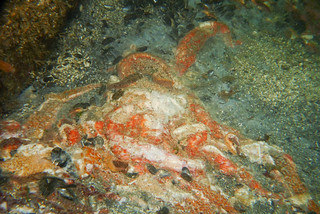

Partial remains of a disk and white, dead starfish tissues..
In some cases, arms were separated with tube feet still moving around
What makes this such a concern? OTHER starfish species in completely different lineages also seem to be affected. The sea star predator, Solaster dawsoni was also observed in various states of distress..
Solaster feeds on other starfish and does feed on Pycnopodia, so is there a connection?? Especially with the recent population explosion??
So What's Going On?
So, there were a number of different ideas that buzzed through my head. Again, this is all SPECULATION on my part...
1. Is this related to the population explosion, observed almost 3 years ago?? Could the huge populations from 2010 be suddenly dying off? Famine? Disease? (see below) This would be an unusual (or at least poorly known) phenomena. I've seen Pycnopodia in aquaria live out long lives, so I don't think this is some kind of "natural causes" thing...
2. Could this be a disease? Jonathan has mentioned the ciliate (Protist) parasite which inhabits sea stars in the Pacific Northwest. The ciliate effectively castrates the host, but has never been observed to actually cause much more damage than that. And accounts of the ciliate suggest that it occurs in a very small % of the overall population.
There are accounts of many sea urchins being decimated by various bacterial infections, such as Bald Sea Urchin disease but my skim of the literature suggests that there isn't anything known about similar diseases in sea stars. Most mass-mortalities of seastars have been associated with environmental changes- freshwater from rains, storm and wind, toxicity in the water from geological events and so on...
Could this be related to what has been observed on the East coast with Asterias? See also this report. Where populations of the well-known intertidal starfish (and btw, SAME family as Pycnopodia) have been undergoing population declines for unknown reasons.
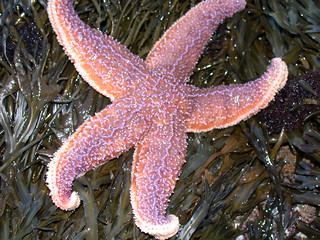 |
| Image by lifeboy252 |
Have other species in completely different ecological regimes died?
SO FAR, this has been observed only in the British Columbia region. Hopefully, this is just an isolated incident and nothing that will be slowly moving in any other direction.
I'm not an ecologist or an invertebrate pathologist.. so maybe someone out there with an appropriately equipped lab will embrace this and seek out the answers? and hopefully whatever it is, won't be much more widespread..
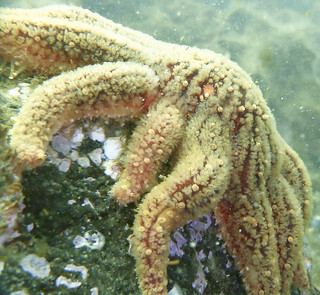
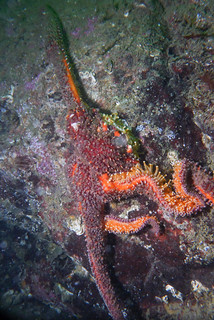
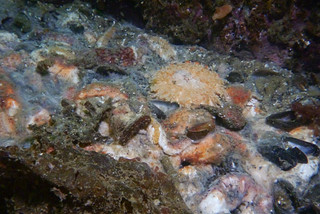
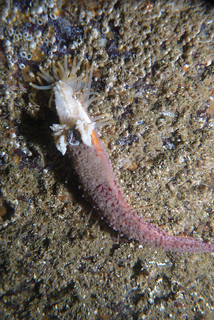
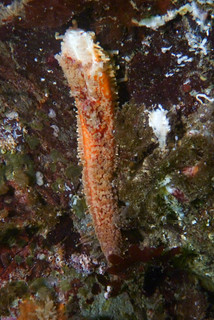
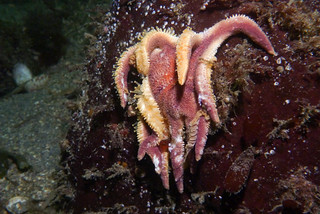
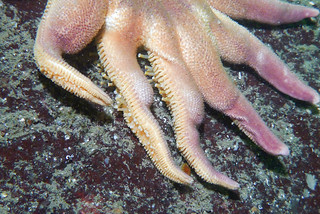
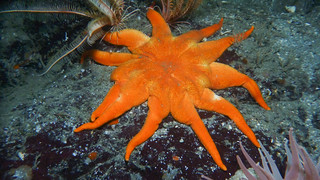
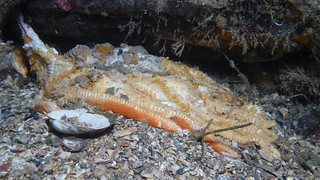
Sea stars in the late 60s-early 70s in the Gulf of California and Southern California suffered massive die-offs similar to this one, and it was blamed (unconvincingly) on warm temperatures that supported infectious disease as has been seen with sea urchins. However, the actual cause was never identified. It would be good to get a pathologist/ bacteriologist on site as soon as possible, but who would that be?
ReplyDeleteI will ask Jonathan if anyone at his university would be interesting in picking up the project...
ReplyDeleteVancouver recently had some severe rain, and at one part of the video I can see fresh water. Perhaps the animals are dying following an osmolarity shock? Another more sinister reason may be mischievous divers injecting bleach for some misguided reason...
ReplyDeleteChris BC
I'm told depth was about 20-50 feet. Could fresh water be affecting animals at that depth? It doesn't like it to me but perhaps there is something unusual?
ReplyDeleteIt occurred to me that it could be someone cutting them up..but the impression I got was that it was a LOT of individuals..
Any idea the dissolved O2 levels there? The only time I've seen anything remotely similar was during a low O2 event in Hood Canal, WA.
ReplyDeleteIn other news though, I did a few surveys recently and noted a conspicuous absence of Sunflower Stars. It was strange - but there were no dead/dying ones scattered around. Just none at all. This was on the Pinnacle in Hood Canal. (not an area that's typically affected by low O2 events that happen in south Hood Canal).
@Janna, I'm not sure about the O2. There wasn't any unusual absence of fish life that I usually see in areas of low 02, and though we had one LARGE rainfall about 2 days before we started noticing the mortality, it's not as if we're strangers to rain up here in the Northwest, right? :) The water didn't seem to be overly warm, and yesterday it even seemed a little colder (~52F) than I've been seeing all summer long. I personally noticed it at two sites; Kelvin Grove and Whytecliff Park. Kelvin seems to have been going on for longer, with the state of decay far more advanced. There was a lot of LOCAL signs of anaerobic bacteria around the decomposing animals, and I took one photo of a feather-duster worm pushed right out of its burrow in the midst of a big pile of dead Pycnopodia, here: http://www.flickr.com/photos/dryodora/9661971298/in/set-72157635359370052
ReplyDeleteMy observations of low O2 events (and I've seen many of them over the years) is that Parastichopus (California Sea Cucumber) and Pycnopodia show stress signs long before fish show anything. You don't need dead fish for a low O2 event.
ReplyDeleteWith that being said however, what you observed, with chopped off arms and segmented critters, it doesn't sound like a low O2 event at all.
I also don't suspect the freshwater runoff, as we get that year round. And temps vary year round as well.
'Tis a mystery!
http://pnwscuba.smugmug.com/Diving/Sund-Rock-Low-Dissolved-Oxygen/n-rbVpV/i-vcpqDWr
ReplyDeleteI did a study in Bamfield earlier this summer and we recorded this tissue degradation in close to 25% of our specimens. We found it similar to wasting disease. A paper about wasting disease in Pisaster:
ReplyDeletehttp://ecite.utas.edu.au/76464
We were shocked at how quickly the degradation occured with mortality occuring 3 days after showing the first symptoms (abscesses forming).
All specimens showed decreased speed and feeding behavior.
Very interesting observations. My first guess is that it may be the same wasting disease that can affect Pisaster ochraceus. The causative agent is poorly understood (a Vibrio, maybe?), but it is different from the ciliate castrator. Speaking of Pisaster ochraceus, that species will drop its arms about 10-14 days after a low salinity stress event. The arms can still crawl around a bit, but they eventually run out of steam and decompose into piles of white goo. This is pretty similar to what you have in your images. But I'd be pretty surprised if it was low salinity stress at this time of year. The salinity in the southern Strait of Georgia is largely driven by the Fraser River, and the outflow peaked this year way back in May. I'd be quite interested in talking more about this if you have other observations and/or ideas.
ReplyDeleteChris Harley, UBC Zoology
@Chris Harley: Thanks for the input! Just got back from an evening dive at the Cut at Whytecliff, and more of the same. It's just carnage out there. I concur with your statement about salinity in the lower strait of Georgia, especially since it's been such a dry summer with very little rain to add to the Fraser plume. Mike Delaney suggested it might be heat stress, and it's possible that this, plus a wasting disease like you're describing, could be a double whammy. I did shoot some video tonight, with some decent lighting, so once I edit it (Likely tomorrow night) I'll be sure to post a link to it.
ReplyDeleteAnyone consider perhaps that maybe the Japanese nuclear plant has any contribution? It has been spewing radioactive water and waste into the pacific for over two years, perhaps our coastal species are only now feeling the effects?
ReplyDeleteTalking of my experience with Asterias, I would not discard a freshwater runoff. It is not necessary for salinity to go very low, it works also if it's happens very fast. If you talk about a dry summer and sudden abundant rain that may do the trick. The two pictures of somewhat swollen animals made me think of that too. I have seen Asterias dying of salinity shocks, high temperatures, anoxia and mechanical damage+stress. In all the cases mortality occurred in a similar way (except for the swelling, only in salinity): first they start dropping arms and developing white patches (I believe is decaying tissue), perforations in the body wall, and finally mortality.
ReplyDeleteCould this have something to do with ocean acidification? Ossicles are calcium carbonate, the same as coral reef skeletons. If the CO2 levels are too high, maybe its causing the sea stars to dissolve?
ReplyDeleteFor those with the radiation and ocean acidification questions. Both of those would be widespread effects, not only on sea stars but other animals as well. There are several reasons these are ruled out but basically, there don't seem to be the widespread symptoms one would expect to see from either of those sources.
ReplyDeleteWhat we are seeing here seems to be specific and relatively qualified in scope..
thanks for the input!
We were at Kelvin this evening ( Sept 4) left side by the rock piles
ReplyDeleteTotal devastation,,hundreds of Sunflower stars in various stages of decay.
They were as low as 12 feet down to 70 feet,,,bodies arms,,,some decaying in a mass in the sand.
Whatever it is has worked very fast,,we were at this same dive site a month or more ago and there was no evidence that this was happening then.
At Porteau wall, this past weekend,,,there were an abundant population of what appears to be healthy Sunflower stars...certainly no evidence that the same condition was happening as at Kelvin Grove site.
Our long-term rocky intertidal monitoring group (MARINe) has also seen evidence of seastar wasting, primarily in Pisaster ochraceus, on the Olympic Coast of WA, and in Sitka, AK.
ReplyDeleteAs far as I know this has not yet been seen in the San Juans, though we're just starting the lookout. Our weather station @ Friday Harbor Labs shows that salinity has been "normal" for inland waters (~30 PSU) since the last Fraser event in early August: http://140.142.199.7/vdv/VV_Frame.php
ReplyDeleteSee "underwater" in sites list for data. Ignore apparent salinity drop on 8/23 & 8/24 caused by equipment maintenance.
Pycnopodia are prone to dropping their arms (= looks like they were cut up) when stressed by biological or physical environmental factors.
I just received a report of Pisaster wasting disease in Santa Cruz.
ReplyDeleteIt occurred to me that if wasting disease was to have affected Pycnopodia that maybe it could have had a much more acute affect given their density and abundance from the population explosion a few years ago. Normally sunflower stars are pretty widely spaced..
Wow, didn't know this was happening. Some kind of anti pycnopodia kaiju? If it's happening in BC, is it happening elsewhere in the Salish Sea?
ReplyDeleteTo bring in an East Coast perspective, there've been news reports of Asterias die offs around the Narraganset and other areas this year, and die-offs in the past few years in the GoM. There's a lot of speculation on causes (temperature keeps popping up as a facilitator of disease). The generality of this seems somewhat unsettling. And interesting. I do wonder if there's a general relationship between particular environmental drivers and echinoderm diseases - one that we might want to think about projecting into the future.
ReplyDeleteHrm.....
Jarrett,
ReplyDeleteWasting disease seems to be associated with higher water temperatures. So, it seems reasonable to assume it exacerbates the pathogen (whatever it might be). The more of these accounts I put together the more I wonder if we should be more concerned about the frequency of the disease outbreaks..
I will need to put this together on a map at some point..
We see this quite often in our touch tank at the aquarium. I have generally associated it with warmer temps and just general stress. It happens extremely quickly, even if starfish not handled. I suspect both one (or more) pathogen(s) + stress in natural populations - but what?
ReplyDeleteYes, the symptoms are not unusual to people who work with stressed marine inverts in aquaria. But to see it in the wild and among so many? Especially after the huge population explosion. Its a bit of a mystery. At least until more work can be done to ID the pathogen..
ReplyDeleteI found your post after noticing a large number of sea cucumbers washing up on the beach recently here in Santa Barbara, ca. I saw someone reply that about Santa Cruz, could it be a that large of a related phenomenon? The water has been quite warm here recently, at least at the shore.
ReplyDeleteIts difficult to say without seeing what you are seeing. There are many specific issues that would need to be examined. The species of the sea cucumber, whether they have shown signs of disease, etc. Sometimes storms will stir up the bottoms and wash animals ashore. So a better sense of what you're seeing would be necessary.
ReplyDeleteA bit off subject, but is there anyone testing West Coast marine life/consumable fish for Fukashima radiation? If so, where can we read about the results?
ReplyDeleteTrust me, its not an issue. Wasting disease has been going on much longer than Fukushima and no other animals in the area are affected in this way.There's plenty more mundane things to worry about than radiation.
ReplyDelete